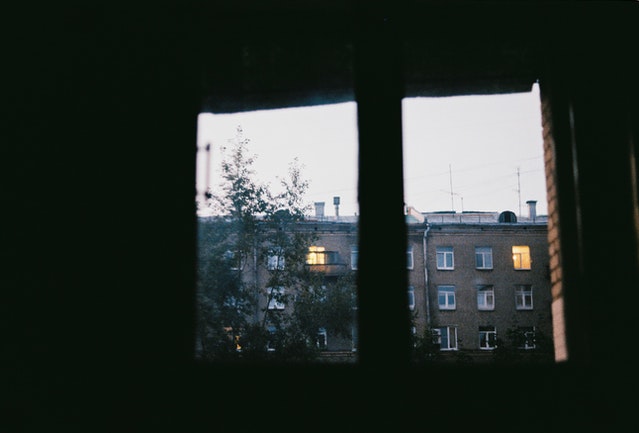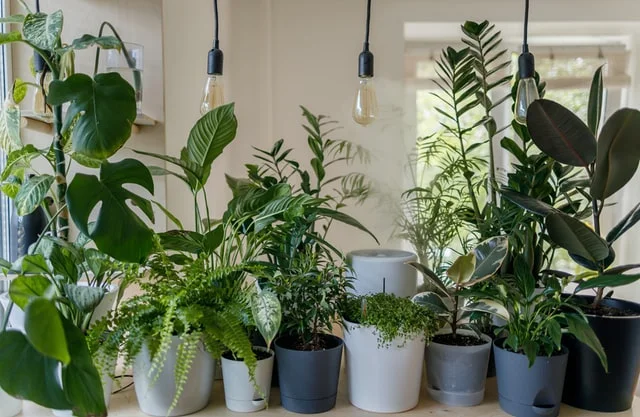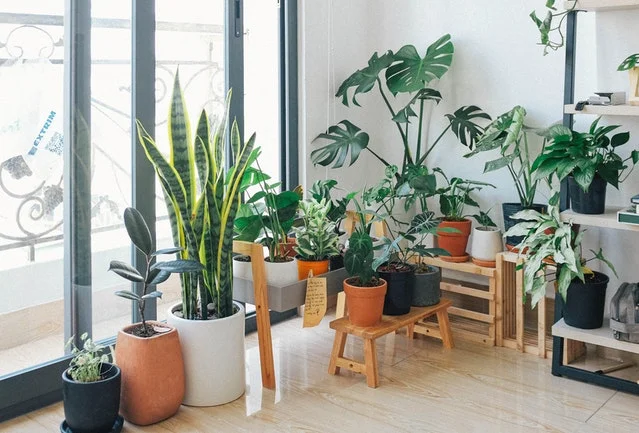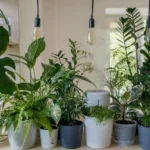Have you ever given any regard to the amount of direct or indirect sunlight that your houseplants prefer? There isn’t a single plant that can survive without sunlight in some kind. Some plant species either do not require as much sunshine as others do or are able to thrive in environments with less sunlight.
But in order to thrive and maintain their health, every plant need some amount of sunshine. Your plant will not be able to reach its full size and potential without the assistance of sunlight. There are even plants that can use this energy to convert sunlight into oxygen-rich air.
If you’ve ever read a plant care guide, you’ve probably encountered statements about putting a plant in “a west-facing window.” If you are just getting started, this could be a bit perplexing for you, and you might find yourself wondering if it actually makes a difference which way your window is facing. What difference does it make whether you place your plant in a north or west-facing window?
In this plant care article, we’ll look at whether the type of solar exposure your plant receives affects and what the difference between the four directions is.
In this article, we’ll go through the following four orientations in detail, as each one has its own advantages:
- North
- East
- South
- West
Table of Contents
An important remark regarding the directions
Before we get started, there is one thing that you should bear in mind: these directions can be different for you depending on where you reside. For instance, if you reside in Australia and you read a plant care guide published by someone in the United States of America, the recommendations in that guide will need to be followed in reverse order for you to be successful.
Therefore, a window in the United States that faces south is equivalent to a window in Australia that faces north. This applies to any country in the northern or southern hemispheres.
In order to make it simpler for you to apply this information to your houseplants, I will make sure to cover both the northern and southern hemispheres in my plant care guide. Let’s begin with a north-facing window!
North-facing windows
In the first paragraph, I pointed out that the orientation of the window facing north in the southern hemisphere is the opposite of what it is in the northern hemisphere. If you are in the southern hemisphere, the light coming in from the windows facing south will be comparable.
Northern hemisphere

When located in the northern hemisphere, a window that faces north is one that, in general, does not get a great deal of sunshine. Because the sun usually always rises in the south and sets in the north, the window on the northern side of your home will not receive a significant amount of direct sunlight.
This light is ideal for plants that thrive in dimly lit areas or those that thrive best in indirect sunshine. Plants that fall within this category include, but are not limited to, the spider plant, the ZZ plant, and the peace lily.
Southern hemisphere
Since the sun rises in the north and sets in the south, a window that faces north will let in a lot of natural light in the southern hemisphere. The result is the creation of an environment that is ideal for those kinds of plants that thrive in the sun for the most of the day.
Cacti, Alocasias, and Crotons are some examples of plants that thrive in this kind of sunshine. Succulents also grow quite well in this environment. This kind of light is comparable to the light that comes through a window that faces south in the northern hemisphere.
One thing to keep in mind about the window that faces north in the southern hemisphere is that it receives a significant amount more shadow during the summer than it does during the winter.
During the summer, the sun is at its highest point in the sky and casts a nearly vertical beam of light. It’s possible that the rest of the room won’t get as much light as you’d like it to, but it’ll be wonderful for the plants on your windowsill that thrive in the sunlight. It is recommended that you look via a window that faces west in order to do this.
East-facing windows

Both the northern and the southern hemisphere have an east-facing window that looks the same. The sky is always brightest in the east, and the sun always sets in the west. What exactly does this imply for the health of your plants? What this indicates is that you will be able to see some sunlight in the morning, when the sun is at its lowest point in the sky. Your plants will only receive a few hours of dim sunlight as a result of this.
This kind of light is comparable to the light that comes in from windows facing the north, although it is much stronger in the morning. This would be an excellent spot for a few low-light plants with interesting leaf patterns, such as variegated leaves.
Because of this variation, the plants require a greater amount of light in order to obtain the same amount of energy from the sun. Only the green sections of the leaves are able to properly absorb the sun’s rays, while the other parts of the leaves, which are variegated, are unable to do so.
Plants that thrive in northern-facing windows in the northern hemisphere and southern-facing windows in the southern hemisphere will also thrive in this sort of light. These two types of plants would be ideal for growing in this type of light.
South-facing windows
The light that shines through windows that face north in the southern hemisphere is equivalent to the light that shines through windows that face south in the northern hemisphere.
Northern hemisphere
The light that comes in from the window that faces south is bright light that will be present for the most portion of the day. A location near this window is ideal for succulents and cacti, two types of plants that thrive best when they receive a great deal of sunshine.
Any room that has a window similar to this one may be utilized for growing plants that require varying amounts of sunshine exposure because light enters the room via this window throughout the most of the day. You may relocate a plant that requires a bit less light farther away from the window, where it will not get as much light. This is the case if the plant has a lower light requirement.
This is not possible in a room with a window facing north or east. In these spaces, the light that is further away from the windows is just not powerful enough to support the growth of most plants. In the northern hemisphere, the light that enters a room through a window that faces south is ideal for growing a wide range of houseplants.
Southern hemisphere
Windows that face south in the southern hemisphere are equivalent to windows that face north in the northern hemisphere in that they only receive a very little amount of sunlight exposure. Because of this, there is a restriction on the kinds of plants that may be placed in this room or near the windows.
However, this is the kind of environment where low-light plants thrive. The majority of plants that require a little bit more light should be placed close to a window, or you should really consider transferring them to a room that gets more sunshine.
West-facing windows

A window that faces west is equivalent in both the northern and southern hemispheres. A window that faces west does not receive any sunlight in the morning but does receive sunshine beginning in the early afternoon and continuing all the way through sunset.
Because of this, it is an excellent location for plants that require a significant deal of sunshine, in particular direct sunlight. The majority of tropical plants, such as Monsteras and Alocasias, will thrive in these conditions.
It is also beneficial for plants, such as cactus and succulents, that may be placed right up against a window and that require as much sunshine as they can receive. You can position these plants in close proximity to the window.
Because the light is considerably more steady throughout the day, western facing windows are often recommended more in plant care instructions than either northern or southern facing windows. This is because western facing windows face west.
Even in the winter and summer, the amount of sunlight that enters your home via the west-facing windows is significantly more than the amount that enters through the south-facing windows.
During the summer, when the sun is at its highest point in the sky, the shade that you receive via your south- and north-facing windows will be more than the sunlight that they let in. However, the windows that face west continue to get sunshine throughout the afternoons and evenings.
Conclusion
The question of whether or not the orientation of our houseplants to the sun is important was raised at the beginning of this article. The information contained in this guide has taught us that the varied aspects of sunlight exposure are determined by the direction in which the sun is shining.
Your houseplants will benefit from increased growth and overall health if you employ a combination of these various forms of lighting to simulate natural sunshine as closely as possible.
I appreciate you taking the time to read my article. I really hope that this information is of use to you in maintaining the health and beauty of your plants.
Frequently asked questions
Can you use a north-facing window for plants?
Yes, plants that cannot live in light surroundings benefit from a north-facing window. If you live in the southern hemisphere, this window receives a significant amount of direct sunshine; thus, you should carefully select the plants that you put in it.
Can you use an east-facing window for plants?
In the mornings, there is some sunshine streaming in through the windows that face east. Plants that thrive in dimly lit environments will find this to be an ideal location.
Can you use a south-facing window for plants?
Sun-loving plants, such as succulents and cactus, thrive very well in a room with a window that faces south. You may place low-light plants in a south-facing window because this window doesn’t get a lot of sunshine in the southern hemisphere, which is why you should utilize this window.
Can you use a west-facing window for plants?
Sun-loving plants, such as succulents and cactus, thrive very well in a room with a window that faces south. Even during the darkest months of the year, the sunshine that enters a room through a window that faces west will be the most abundant.
Pictures used in this article:
Photo by Huy Phan: https://www.pexels.com/photo/potted-green-indoor-plants-3076899/
Photo by Tobias Bjørkli: https://www.pexels.com/photo/aurora-borealis-and-sun-visible-in-sky-of-northern-norway-11180711/
Photo by Anastasia Shuraeva: https://www.pexels.com/photo/view-of-a-building-from-a-window-4091195/


